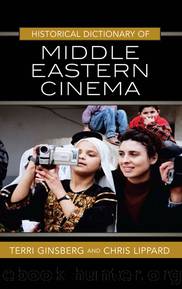Historical Dictionary of Middle Eastern Cinema by Ginsberg Terri;Lippard Chris; & CHRIS LIPPARD

Author:Ginsberg, Terri;Lippard, Chris; & CHRIS LIPPARD
Language: eng
Format: epub
ISBN: 500833
Publisher: Scarecrow Press
KOKER TRILOGY. Although director Abbas Kiarostami does not necessarily consider the three films he made between 1985 and 1992 in the Koker region of Gilan in northern Iran to comprise a trilogy, they are nonetheless seen that way by many critics. Where Is the Friendâs House? (1986), the story of a schoolboy in dogged search of his schoolmateâs house in a neighboring village in order to return his notebook and thus prevent their teacherâs wrath and the friendâs possible expulsion, is the epitome of the child-centered, broadly humanist tendency that characterized art filmmaking in Iran under strictures of Islamic censorship. Made for the Center for the Intellectual Development of Children and Young Adults, the film is a deceptively simple morality tale not incompatible with the dominant ideology to which the Ruhollah Khomeini regime in fact adhered only inconsistently.
The villages that served as location settings for Where Is the Friendâs House? suffered badly from the Rudbar earthquake of 1990, prompting Kiarostamiâs return to ascertain the condition of his entirely nonprofessional local cast. Life and Nothing Mor e (aka And Life Goes On) (1992) is a fictionalized version of that quest, in which a directorial figure attempting to find the protagonists of his film performs an obvious parallel to the search for the house in the first film. Although he eventually receives word that they are safe, the director does not actually locate the boys. In the third film, Through the Olive Trees (1994), however, they are encountered quite casually, as a production assistant on the making of the film-within-the-filmâwhich indeed turns out to be Life and Nothing Moreâenlists them to find potted plants that will play a role in a scene of which we are to see repeated takes. Through the Olive Trees opens with a directorial figure (Mohammed-Ali Keshavarz, the trilogyâs only professional actor) announcing that he is indeed but an actor playing a role; later we see him in discussion with and directing the âdirectorâ of Life and Nothing More.
Thus, each film changes the way an audience relates to the earlier films, as it foregrounds their constructedness. The latter two are also key documents, along with Close-Up (1990), in Kiarostamiâs exploration of the relationship between documentary and fiction. Aside from its self-referential nature, the trilogy is noteworthy, among many other things, for its motif of zigzagging paths, a long dark sequence in Where Is the Friendâs House?, and many long-takeâlong-shot combinations including those that end the last two films. These devices advanced an aesthetics of ambiguity that endeared Kiarostami to foreign critics and audiences; however, the trilogy has also been criticized within Iran for romanticizing a rural lifestyle and exploiting the Rudbar earthquake.
KTARI, NACEUR (1943â). Ktari studied film in Paris at the Institut des hautes études cinématographiques, then in Rome at the Centro Sperimentale de Cinematografia, before making his debut with one of Tunisiaâs most successful films on emigration to France, The Ambassadors (1975, coproduced with Libya), which concerns the development of collective class consciousness by Tunisian migrant workers in France as they organize for better conditions and treatment.
Download
This site does not store any files on its server. We only index and link to content provided by other sites. Please contact the content providers to delete copyright contents if any and email us, we'll remove relevant links or contents immediately.
Still Foolin’ ’Em by Billy Crystal(36026)
Spell It Out by David Crystal(35836)
The Great Music City by Andrea Baker(30769)
Professional Troublemaker by Luvvie Ajayi Jones(29415)
Trainspotting by Irvine Welsh(21008)
Call Me by Your Name by André Aciman(19890)
We're Going to Need More Wine by Gabrielle Union(18623)
The Secret History by Donna Tartt(18135)
Cat's cradle by Kurt Vonnegut(14749)
Ready Player One by Cline Ernest(13957)
Molly's Game by Molly Bloom(13883)
Bombshells: Glamour Girls of a Lifetime by Sullivan Steve(13679)
The Goal (Off-Campus #4) by Elle Kennedy(13192)
Leonardo da Vinci by Walter Isaacson(12783)
The Social Justice Warrior Handbook by Lisa De Pasquale(11949)
4 3 2 1: A Novel by Paul Auster(11776)
The Break by Marian Keyes(9074)
Crazy Rich Asians by Kevin Kwan(8882)
Adultolescence by Gabbie Hanna(8583)
